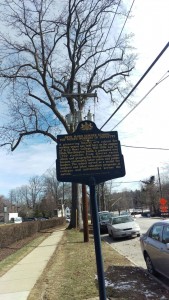As Monica mentioned in class, my project has had a slightly different trajectory than most. I came into this class in January with an idea of what I wanted to propose, something that was born from my senior thesis and the protests at various universities (including our own) that occurred this past November.
The specific impetus of my idea was the removal of the bust of Woodrow Wilson that previously sat (stood? was stationed?) on the first floor of Canaday Library. It had disappeared with no explanation sometime in late November or early December, and while I could only assume its removal had something to do with the protests regarding Wilson’s legacy at Princeton, it took me until mid-January to get an explanation of the specific situation that led to its removal.
I was frustrated by the bust’s removal because I felt, particularly in opposition with the laudatory sign about Wilson that stands behind Denbigh, that this bust would have offered us a chance to challenge Wilson’s legacy, rather than avoiding or denying it, by labelling the bust with details about Wilson’s life and the problematic agenda he advanced. As the petition to rename Thomas Hall began to circulate, I started to wonder whether a plaque of some sort could also be attached to M. Carey Thomas’s bust on the third floor of Canaday to a similar purpose of problematizing her legacy. Wandering around Canaday also made me realize that any number of the items on display– busts, artwork, you name it– is unlabelled, leaving students with no understanding of who these people or what these artifacts are, and why they matter to the College.
So, in a paragraph, the proposal I submitted to Canaday was: “This proposal recommends that the Bryn Mawr College Library & Information Technology Services provides interpretive labelling for all artifacts currently or recently on display in Canaday Library. It provides a survey of what Canaday’s current layout is and contrasts it with the labelling system used in Carpenter Library. Furthermore, it offers two examples with suggested label texts: one bust currently on display and one that was recently removed, with research done on the people they depict and the history of the artifacts. The proposal argues that such an undertaking would offer members of the Bryn Mawr community—staff, students, and faculty alike—a chance to more fully engage with the history of the College.”
For my sample labels, I drafted descriptions that could go next to the M. Carey Thomas bust and where the Woodrow Wilson bust once was. I submitted the proposal two weeks ago, and have a plan to meet with the library about it at the end of the month. Also included in the proposal were photographs of various unlabelled artifacts around Canaday, including one of the shelf on the Canaday A floor that used to host President Wilson. There are still scratch marks on that bookshelf, because the bust is quite heavy and there was some trouble moving it. This is the image I chose to represent my project, because it speaks to the absence of historical explanation, and to the fact that while we may not want to acknowledge it, traces of history remain all over campus.



